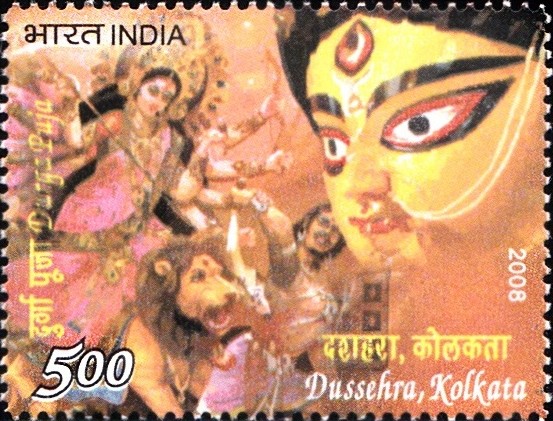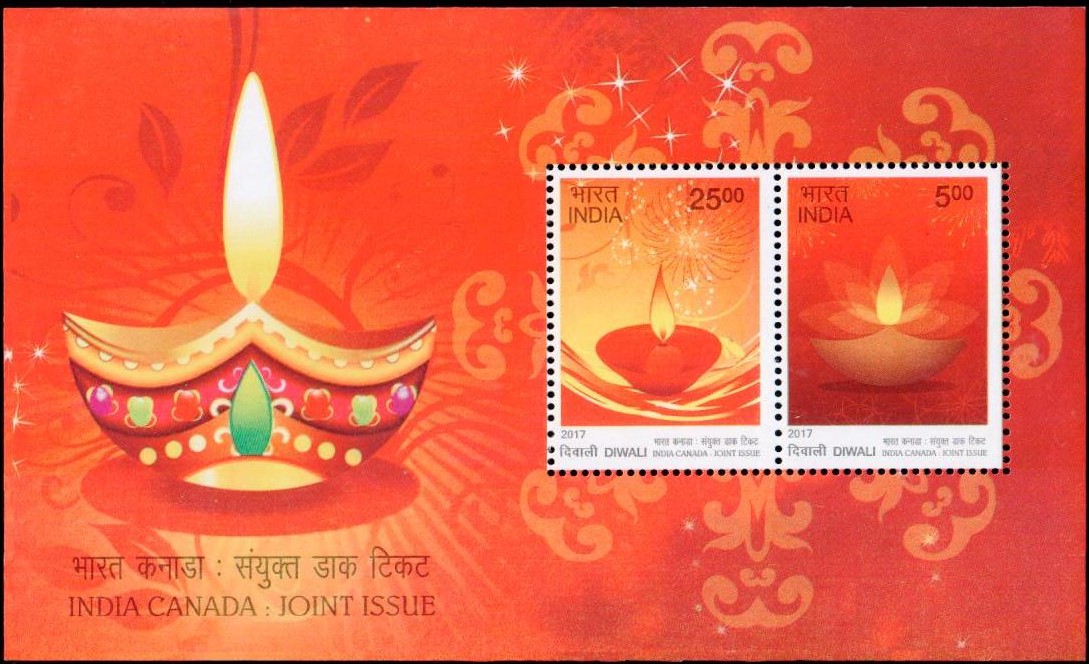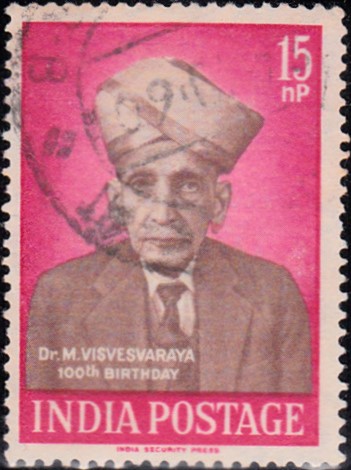
Festivals of India
A Miniature Sheet consisting of 3 nos. of commemorative postage stamps on the Indian Festivals – Durga Puja, Dussehra and Deepavali :



 Issued by India
Issued by India
Issued on Oct 7, 2008
Issued for : India Post commemorates the traditions and gaiety of the festivals of India with a set of three stamps – two on Dussehra and one on Diwali.
Credits :
Stamp & FDC : Brahm Prakash
Cancellation : Alka Sharma
Type : Miniature Sheet, Mint Condition
Colour : Multi colour
Denomination : 500 Paise each
Stamps Printed : 3.0 Million each
Miniature sheet : 1.0 Million
Printing Process : Photogravure
Printer : India Security Press, Nasik
About :
- India, the vibrant land of mythological tales, of Gods and Goddesses and thousands beliefs, has evolved over centuries as a mystic land of festivals. These colourful and happy festivals bind the people of the nation across various states and religions in unique way and provide a spectacle that cannot be experienced anywhere else in the world. Two very important and popular festivals of India are Dussehra and Diwali.
- The festival of Dussehra, also known as “Vijayadashami” is one of the fascinating festivals of India and is celebrated with joy and enthusiasm for ten continuous days. Dussehra, or the tenth day, as it literally means, marks the end of the nine days Navratri. The first nine nights are spent in the worship of Goddess Durga. This festival falls in the month of Ashwin (Sep-Oct). The legend underlying the celebration, as also its mode of conduct, vary vastly by region; however, all festivals celebrate the victory of the forces of Good over Evil.
- In North India, the 10-day festival commemorates the victory of Rama, over Ravana, the ruler of Lanka, who according to the Ramayana had abducted Sita, wife of Rama, and held her captive. The festival is celebrated with much gusto. Ramlilas, an abridged dramatization of the Ramayana – is enacted with much public fervour all over northern India during the period of the festivities. The burning of the effigies of Ravana, Meghnath and Kumbhakarna on Vijayadashami day, signifying of the victory of good over evil, brings the festivities to a colourful close.
- In Southern, Eastern and Western parts of India, the festival of Navaratri which culminates with Vijayadashami, commemorates the legend in which the Goddess Durga, also known as Chamundeshwari or Mahishasur Mardini, vanquishes the demon Mahishasur, an event that is said to have taken place in the vicinity of the present day city of Mysore in Karnataka. According to a Puranic legend, demon Mahishasur vanquished the gods and their king, Indra, who approached the Holy Trinity, Brahma, Vishnu and Mahesh. They in turn sought the help of the divine mother Durga who, equipped with lethal weapons, riding a ferocious lion, in all her awesome majesty, killed Mahishasur.
- According to another legend in the great Indian epic, the Mahabharata, the Pandavas had to spend 12 years wandering in the forest and one year in hiding. The Pandavas spent their last year in the court of Virat. At the end of one year Pandavas regained their arms from the shami tree declared their true identity. Kauravas, having learn of Pandavas hiding place, attacked Virat but were vanquished on Vijayadashami day. The exchange of Shami leaves has therefore become the symbol of glory and triumph.
- In Bengal, the festival is celebrated as Kali Puja or Durga Puja, while in Tamil Nadu, the festival incorporates worship of the goddesses Lakshmi, Saraswati and Shakti. Durga Puja, or Durgautsav of Bengal has earned international repute for its majestic celebrations, puja pandals, exquisite idols of the Goddess and the gaiety and ritual traditions. In the nine days long celebrations of Durga Puja. Goddess Durga, is worshipped in different forms like as goddess of valour, wisdom and wealth. On Vijayadashami (tenth day) the idol of Durga is immersed in water after performing customary rituals. Apart from being a festival, Goddess Durga has become a socio-cultural event that celebrates the cheerfulness of life, the vibrant culture, the set rituals and traditions. Durga Puja is celebrated with equal & festive spirit in other states of India like Manipur, Orissa, Assam, Bihar, Delhi, Jharkhand, Uttar Pradesh, Punjab, Haryana and Himachal Pradesh.
- The festival of Navratri acquires quite a fascinating and colourful dimension in the region of Gujarat, and in some parts of Rajasthan and Maharashtra. The highlights of the festival are the extremely colourful dances of Garba and Dandiya-Rasa where men and women of all sects perform. The Raas has its origin in the life scenes of Lord Krishna and is associated with the agricultural rites while Garba is performed only by men and is related with the fertility cult or the mother aspect of Navratri.
- In Southern India, over the years Mysore has become synonymous with Dushara or Dussehra festival. This festival has been celebrated in Mysore with great pomp and show since centuries. Today Dasara in Mysore has become the state festival of Karnataka. The famous Mysore Palace, houses, shops and important buildings in the city are decorated and illuminated for the period of the celebrations. As part of the celebrations renowned musicians of Karnataka and from other states perform in front of the illuminated Palace. The Palace is open to the public and the famous royal throne is displayed, the main attraction is the procession in which the idol of Goddess Chamundeshwari is kept in the golden howdah on top of a decorated elephant and taken round the city. In the evening there is beautiful torch light procession and a stunning firework display.
- Of the festivals of India, Diwali is one of the most significant, grand and auspicious occasions not only celebrated in India but other parts of the world too. ‘Diwali’ or ‘Deepavali’ is a festival of lights. In Sanskrit word Deepavali derives as ‘Deep’ meaning diya or light and ‘Avali’ meaning a row – a row of lamps.
- Diwali, celebrates the abundance of autumn harvest and is dedicated to various gods and goddesses. The festival, according to legends, marks the home coming of Lord Rama, his wife Sita, and his brother Laxman to Ayodhya after fourteen years of exile. The tradition of lighting diyas and candles dates back to history when the people of Ayodhya lighted lamps throughout the kingdom to welcome them. Diwali also celebrates the power of the three goddesses, Lakshmi, Kali and Saraswati.
- The magnificent jubilation of Diwali celebrations is marked by multi-coloured Rangoli designs, special pooja ceremonies, lines of lamps, floral decorations, fireworks, exchange of sweets and gifts that lend grandeur to the occasion. Every home shines with the glow of twinkling diyas or candles to welcome Lakshmi, the Goddess of wealth and prosperity. Diwali is an occasion for cheerfulness and togetherness. It is celebrated as the victory of light over darkness and good over evil.








[…] India we send greetings on festivals like Deepawali, Baishakhi, Dussehra, Pongal, Christmas, Bihu and Id, besides other personal occasions to express a variety of emotions […]
[…] of the family deity usually situated in one corner of the kitchen. On the sacred day of the “Durgashtami” both walls flanking the kitchen door were ritually painted with images of Goddess Durga. These […]
[…] become now an established feature as in most other countries. We send greetings on occasions like Deepawali, Pongal, Durga Puja, Baisakhi, Bihu, Christmas, Id and other regional […]
[…] of folk songs, notes and absorbing their characteristic style of singing. During those days after Durga Puja and during Holi, music conferences were organized at the ancestral home of S.D. Burman, where […]
[…] year’s exile. It is a festival of lights and festivities. It comes off about twenty days after Dussehra and shows the advent of […]
[…] Shirdi Sai Baba entered Mahasamadhi on 15th October, 1918 (Tuesday). It was the day of Dussehra or Vijayadashmi. Various temples and organisations, dedicated to Shri Shirdi Sai Baba and the […]
[…] 1931. His greatest achievement was the foundation of the ‘Rashtriya Swayamsevak Sangha’ on the Vijaya Dashami Day (27 September) in […]
[…] Dandiya Raas is a popular folk dance from the state of Gujarat in India. Dandiya Raas is a rhythmic dance performed by young people moving around in a circle in measured steps to the beat of dandiya or sticks that they carry in their hands. The rhythm is maintained by the clacking sticks, with clapping hands keeping pace. The Dandiya Raas is performed with traditional songs and folk tunes to the beat of the dhol and the wind instrument Shehnai. It is associated with the autumn festival of Navaratri. […]